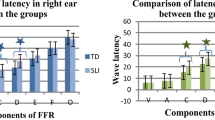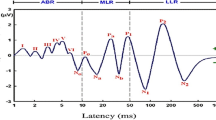Abstract
Due to its objective nature, auditory brainstem response (ABR) evoked by complex stimuli has been gaining attention lately. The present study aimed to compare the speech-evoked auditory brainstem response (speech-ABR) results between two ethnic groups: Malay and Chinese. In addition, it was also of interest to compare the speech-ABR outcomes obtained from the present study with the published Caucasian data. Thirty healthy male adults (15 Malay and 15 Chinese) were enrolled in this comparative study. Speech syllable/da/presented at 80 dBnHL was used to record speech-ABR waveforms from the right ear of each subject. Amplitudes and latencies of speech-ABR peaks (V, A, C, D, E, F and O), as well as composite onset measures (V/A duration, V/A amplitude and V/A slope) were computed and analyzed. When the two ethnic groups were compared, all speech-ABR results were not statistically different from each other (p > 0.05). When the data from the present study were compared with the published Caucasian data, most of the statistical analyses were significant (p < 0.05). That is, Asian subjects revealed significantly higher peak amplitudes, earlier peak latencies, higher V/A amplitudes and steeper V/A slopes than that of Caucasians. The speech-ABR results between Malay and Chinese were found to be essentially similar due to anatomical similarities. Nevertheless, specific normative data for Asian adults are required as their speech-ABR results are different from that of Caucasian males. This issue should be addressed before it can be applied holistically in multiracial countries.


Similar content being viewed by others
References
Mishra G, Sharma Y, Mehta K, Patel G (2013) Efficacy of distortion product oto-acoustic Emission (OAE)/auditory brainstem evoked response (ABR) protocols in universal neonatal hearing screening and detecting hearing loss in children <2 years of age. Indian J Otolaryngol Head Neck Surg 65(2):105–110
Maloff ES, Hood LJ (2014) A comparison of auditory brain stem responses elicited by click and chirp stimuli in adults with normal hearing and sensory hearing loss. Ear Hear 35(2):271–282
Peterein JL, Neely JG (2012) Auditory brainstem response testing in neurodiagnosis: structure versus function. J Am Acad Audiol 23(4):269–275
Kim SM, Kim SH, Seo DW, Lee KWJ (2013) Intraoperative neurophysiologic monitoring: basic principles and recent update. J Korean Med Sci 28(9):1261–1269
Koors PD, Thacker LR, Coelho DH (2013) ABR in the diagnosis of vestibular schwannomas: a meta-analysis. Am J Otolaryngol 34(3):195–204
Shang YY, Diao WW, Ni DF, Gao ZQ, Xu CX, Li FR (2012) Study of cochlear hydrops analysis masking procedure in patients with Meniere’s disease and otologically normal adults. Chin Med J 125(24):4449–4453
Kim AH, Kileny PR, Arts HA, El-Kashlan HK, Telian SA, Zwolan TA (2008) Role of electrically evoked auditory brainstem response in cochlear implantation of children with inner ear malformations. Otol Neurotol 29(5):626–634
Wible B, Nicol T, Kraus N (2004) Atypical brainstem representation of onset and formant structure of speech sounds in children with language-based learning problems. Biol Psychol 67(3):299–317
Skoe E, Chandrasekaran B, Spitzer ER, Wong PC, Kraus N (2014) Human brainstem plasticity: the interaction of stimulus probability and auditory learning. Neurobiol Learn Mem 109:82–93
Hornickel J, Skoe E, Kraus N (2009) Subcortical laterality of speech encoding. Audiol Neurootol 14(3):198–207
Krizman J, Skoe E, Kraus N (2012) Sex differences in auditory subcortical function. Clin Neurophysiol 123(3):590–597
Skoe E, Kraus N (2010) Auditory brain stem response to complex sounds: a tutorial. Ear Hear 31(3):302–324
Song JH, Banai K, Kraus N (2008) Brainstem timing deficits in children with learning impairment may result from corticofugal origins. Audiol Neurootol 13(5):335–344
Chandrasekaran B, Hornickel J, Skoe E, Nicol T, Kraus N (2009) Context-dependent encoding in the human auditory brainstem relates to hearing speech in noise: implications for developmental dyslexia. Neuron 64(3):311–319
Russo NM, Nicol TG, Zecker SG, Hayes EA, Kraus N (2005) Auditory training improves neural timing in the human brainstem. Behav Brain Res 156(1):95–103
Russo NM, Skoe E, Trommer B, Nicol T, Zecker S, Bradlow A, Kraus N (2008) Deficient brainstem encoding of pitch in children with autism spectrum disorders. Clin Neurophysiol 119(8):1720–1731
Tahaei AA, Ashayeri H, Pourbakht A, Kamali M (2014) Speech evoked auditory brainstem response in stuttering. Scientifica (Cairo) 328646
Ngeow WC, Aljunid ST (2009) Craniofacial anthropometric norms of Malays. Singapore Med J 50(5):525–528
Chambers RD, Matthies ML, Griffiths SK (1989) Correlations between various measures of head size and auditory brainstem response latencies. Hear Res 41(2–3):179–187
Don M, Ponton CW, Eggermont JJ, Masuda A (1993) Gender differences in cochlear response time: an explanation for gender amplitude differences in the unmasked auditory brain-stem response. J Acoust Soc Am 94(4):2135–2148
Shahnaz N, Bork K (2006) Wideband reflectance norms for Caucasian and Chinese young adults. Ear Hear 27(6):774–788
Yap MJ, Liow SJ, Jalil SB, Faizal SS (2010) The Malay Lexicon Project: a database of lexical statistics for 9,592 words. Behav Res Methods 42(4):992–1003
Razfar A, Rumenapp JC (2013) Applying linguistics in the classroom: a sociocultural approach. Routeledge, New York
Maddieson I (1984) Patterns of sounds. Cambridge University Press, Cambridge
Chiappa KH, Gladstone KJ, Young RR (1979) Brainstem auditory evoked responses: studies of waveform variations in 50 normal human subjects. Arch Neurol 36:81–87
Edwards RM, Buchwald JS, Tanguay PE, Schwafel JA (1982) Sources of variability in auditory brain stem evoked potential measures over time. Electroenceph Clin Neurophysiol 53:125–132
Acknowledgments
The authors thank all subjects who participated in the study. The authors also thank Prof. Nina Kraus and her colleagues from Northwestern University for their help in the early stage of study.
Author information
Authors and Affiliations
Corresponding author
Ethics declarations
Conflict of interest
The authors declare that they have no conflict of interest.
Ethical standard
All procedures performed in this study involving human participants were in accordance with the ethical standards of Universiti Sains Malaysia and with the 1964 Helsinki declaration and its later amendments or comparable ethical standards.
Funding
This study was part of a research project funded by Research University (RU) Grant (1001/PPSK/812114), Universiti Sains Malaysia.
Rights and permissions
About this article
Cite this article
Zakaria, M.N., Jalaei, B., Aw, C. et al. Are speech-evoked auditory brainstem response (speech-ABR) outcomes influenced by ethnicity?. Neurol Sci 37, 943–948 (2016). https://doi.org/10.1007/s10072-016-2522-0
Received:
Accepted:
Published:
Issue Date:
DOI: https://doi.org/10.1007/s10072-016-2522-0




